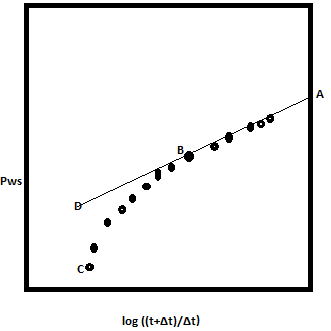This set of Petroleum Production Operations Multiple Choice Questions & Answers (MCQs) focuses on “Well Testing – Recommendations for Obtaining Good Test Data”.
1. Find out the radius of investigation of a particular DST in an infinite radial flow system using Van Poollen equation, given flow time = 120 min, c=2, μ = 0.8 cp, k=50md, Φ = 28 %?
a) 0.48219 ft
b) 0.5584 ft
c) 0.2235 ft
d) 0.4234 ft
View Answer
Explanation: The Van Poollen equation of a particular DST in an infinite radial flow system is ri = \(\sqrt{⟨k×t_p∕Φ×μ×5.76×10^4⟩}\). So by putting the given values on the equation, we get ri = \(\sqrt{\frac{50*120}{5.76*10^4*0.28*0.8*2}}\) which is equal to 0.48219 ft.
2. At which point we’ll get the reservoir pressure if it is a Horner’s plot of DST?

a) A
b) B
c) C
d) D
View Answer
Explanation: We’ll get the reservoir pressure at Point A. Because if we extrapolate the straight line portion of the Curve then the point of intersect of that line with the y-axis gives the average reservoir pressure. It is like when we shut the well for a long period then the pressure that will be showing to the pressure gauge run down on the bottom hole will give average reservoir pressure.
3. By which of the following formula Flow Efficiency can be calculated?
a) (PR – Pwf – ΔPskin)/(PR – Pwf)
b) (PR – Pwf)/(PR – Pwf – ΔPskin)
c) (PR – Pwf – ΔPskin)/ΔPskin
d) (PR – Pwf)/ΔPskin
View Answer
Explanation: Flow Efficiency can be calculated by using the formula (PR – Pwf – ΔPskin)/( PR – Pwf) where PR is the average reservoir pressure, Pwf is the bottom hole flowing pressure and ΔPskin is the pressure loss due to skin. This Flow Efficiency term is the Standing’s extension of the Vogel’s work to account for damaged or improved wells.
4. For a well-draining a cylindrical volume, how can we calculate the FE of that well?
a) [ln (0.47re/rw)+S]/ln (0.47re/rw)
b) ln (0.47re/rw)/[ ln (0.47re/rw)+S]
c) (PR – Pwf)/(PR – Pwf – ΔPskin)
d) (PR – Pwf)/ln (0.47re/rw)
View Answer
Explanation: For a well-draining a cylindrical volume we can calculate the FE of that well by using the formula ln (0.47re/rw)/[ ln (0.47re/rw)+S]. Where S is the dimensionless skin factor. re is the equivalent reservoir radius and rw is the well radius.
5. Vogel’s Equation is not valid for 2 phase flow.
a) True
b) False
View Answer
Explanation: Vogel’s Equation is valid for 2 phase flow. This equation is useful for Inflow Performance Relationship for 2- Phase Flow. It works for a water cut of up to 50%. The equation of Vogel for 2 phase flow is given by q/q0=1- 0.2(Pwf/PR)-0.8 (Pwf/PR)2. Where PR is the average reservoir pressure and Pwf is the bottom hole flowing pressure.
6. In general when a well is in flowing condition then pressure drops after a certain period of time.
a) True
b) False
View Answer
Explanation: Yes it is true. When a well is producing then the pressure inside the reservoir starts to decrease and hence it is obvious that pressure will drop after a certain time. So is the driving force of the reservoir is not enough to produce oil and gas then we have to provide external energy in the natural drive system by using secondary and tertiary recovery methods.
Sanfoundry Global Education & Learning Series – Petroleum Production Operations.
To practice all areas of Petroleum Production Operations, here is complete set of 1000+ Multiple Choice Questions and Answers.
If you find a mistake in question / option / answer, kindly take a screenshot and email to [email protected]
- Apply for Chemical Engineering Internship
- Check Chemical Engineering Books
- Practice Chemical Engineering MCQs
- Check Petroleum Production Operations Books
